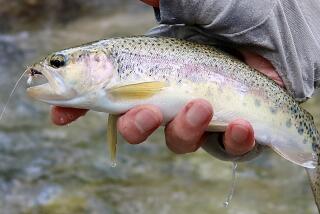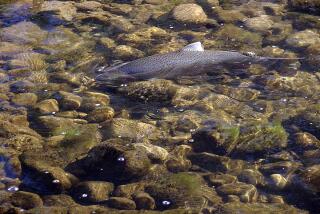Catching ‘Em on the Fly : CHP’s Mike Kingston May Let a Fish Get Away, but Not a Speeding Fisherman
- Share via
BRIDGEPORT, Calif. — It was just after dawn, but fly fisherman Mike Kingston was already running late. Well, hiking late.
While hiking on a Jeep trail, he’d just told two friends that dawn or a few minutes after dawn was too late to begin fishing at his destination, Kirman Lake.
Then, an unspeakable thing happened:
“SSSSSSSSSSS . . . “
That ominous sound was emanating from Kingston’s inner tube, which was strapped to the pack frame on his back.
“Oh, no!” Kingston wailed.
In gray dawn light, Kingston ripped the truck inner tube off his back, put it on the ground and fumbled for the leak.
“Ah, why am I looking for the leak,” he muttered disgustedly. “Even if I find it, I don’t have anything to patch it with.”
What we had was a fly fisherman with a flat.
The inner tube is a relatively recent addition to equipment used by lower-elevation and back-country Sierra fishermen. Tubes-- equipped with a backpack-like nylon sleeve and a seat--enable fly and spin fishermen to reach mid-lake areas unreachable by casting from shore or wading shallows.
They are not foolproof, though, as Kingston discovered. One of the metal hooks on a rubber stretch line he’d used to secure the tube to his backpack frame had rubbed a hole in the tube.
“Back to the drawing board,” he said.
If you enjoy driving at high speed on scenic U.S. 395 in the Sierra, you may have already met Mike Kingston. He’s a California Highway Patrolman, based in Bridgeport. Most days, he can be found just about anywhere between Mono Lake and Sonora Junction, watching for speeders or responding to help at accidents. He’s the Eastern Sierra’s tube-packing, fly-fishing cop.
Kingston is built like a tight end. People wonder how such a ham-handed hulk could create some of the Sierra’s most skillfully tied flies. If you’ve never watched a fly tyer at work, it’s sort of like watching a guy repair a watch. Kingston also teaches fly-fishing classes at Bridgeport City Park each summer.
Look at any well-stocked tackle store in the Eastern Sierra--Filson’s, in Mammoth Lakes, for example--and you’ll find Kingston’s flies for sale. He’s probably best known for a creation he calls the woolly bear caterpillar, which sells for about $1.25. This past summer, he tied 50 dozen woolly bears, but he has tied as many as 100 dozen in previous summers.
It’s an imitation of the fat, juicy black caterpillars that hatch several times every summer on the underside of broadleaf plants hanging over the East Walker River. The East Walker is a designated wild trout stream and its brown trout go into feeding frenzies when the big fuzzy caterpillars fall into the stream.
Kingston said: “My woolly bears work pretty well on the East Walker, whether there’s a hatch on or not,” he said. “But I also use them anywhere I see a lot of brush at the water’s edge. It has a good, lifelike form for a lot of waters.”
As he reached the edge of Kirman (pronounced Carmen) Lake, he pulled out his leather pouch of flies and made a selection, a homemade freshwater shrimp pattern. It was made of olive yarn, had an olive hackle and had been tied with olive thread.
“I’ll start off with a shrimp,” he said. “It might not work, though. When the sun’s overhead, the freshwater shrimp go into those reeds, where the trout can’t see them. That’s why it’s so important to be here when the first light hits the water. Really, you need to be hiking that Jeep road with a flashlight.”
Kirman Lake is a jewel in the Eastern Sierra foothills, resting in a sage meadow beneath the Sierra’s snowy spine, to the west. There are aspens in the area, and their fall orange-gold-yellow colors wind back into the canyons, like little rivers of gold.
As Kingston reached the lake, the cool air was rich with the aroma of sage. The only sounds were the quiet, contented clucks of about 200 coots on the water.
Kingston pulled on rubber waders, rigged his nine-foot graphite fly rod and tied on his freshwater shrimp fly, with a barbless hook. He pulled a tiny file out of a pocket and, with great care, sharpened the hook’s tip.
“This is probably the most important part of fishing, yet the most-often overlooked,” he said. “Factory hooks aren’t sharp enough. It’s that simple.
“The way you tell if your hook is sharp enough is to touch it to your fingernail. If the point is sharp enough to scratch your fingernail or penetrate it, that’s sharp. Remember, a barbless hook will penetrate a fish’s mouth deeper than a barbed hook, providing it’s as sharp as you can get it.”
Kirman Lake is under special management by the Department of Fish and Game. The limit is two trout. As Kingston arrived, only two fishermen were present, an older man and his grandson. As Kingston rigged up, they prepared to leave--taking three- and four-pound brook trout with them.
“You shoulda been here earlier, when they were really hittin’,” the older man said to Kingston, who winced.
“I hate it when people tell me that,” Kingston said.
He waded into the lake, to hip depth, and began casting, near some three-foot-high reeds. On his second cast, he had a hard strike. For a second, it put a deep bow on his rod.
“Hey!” he shouted as the fish apparently wrenched itself free of the shrimp fly.
He cast a few dozen more times, unsuccessfully, then walked or waded completely around the egg-shaped lake, perhaps three-quarters of a mile across at its widest point. He talked about fall fly fishing in the Sierra.
“This I’d rate as one of my favorite fly-fishing waters,” he said. “I like the quality of the fishermen I find here, for one thing. It’s an hour and 15-minute hike in here, so you don’t find the slob types. On a morning when you might find a hundred people at a roadside lake, there might be three or four here.
“For another thing, there just aren’t many places like this where you can find three- to four-pound brook trout on a consistent basis.
“My favorite fly-fishing site overall would be the East Walker (River). I feel like I’m going home, every time I go there. The East Walker just holds a certain mystique for me. And there’s always the chance you’ll catch a really big trout. A DFG crew shocked up a 35-inch, 17-pound brown in there last summer.
“But Kirman is really tough to beat. The best times of the year are May and October. The last two weeks of October are the best--these brookies know winter is coming and they’re trying to fatten up. You do need a tube, though, to get beyond the reeds. Early mornings are best. I’d say I’ve caught two to three times as many fish here in early mornings as in late afternoons.”
The subtle mysteries of such subjects as shadows of the moon, sun and stars, wind and temperature, of known and unknown factors that govern the lives of trout, freshwater shrimp, insects, and fishermen eluded Mike Kingston this day. It’s called getting skunked.
But then, he’d had a flat.
Sudden thought: Has a fly fisherman ever talked Kingston out of a ticket? “Never,” he said. “My mind is made up when I pull ‘em over.
“Sometimes, I’ll pull over a car full of guys who’ve come up here to fish the back country, just like I do. I’ll help ‘em with a tip or two on a good place to fish, but do they ever talk me out of a ticket? Just because they’re fishermen? No way. No one has ever talked me out of a ticket.”
Fair warning, fishermen.
More to Read
Sign up for The Wild
We’ll help you find the best places to hike, bike and run, as well as the perfect silent spots for meditation and yoga.
You may occasionally receive promotional content from the Los Angeles Times.






